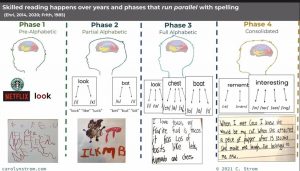Development of the Alphabetic Principle
Thank you to Dr Pam Kastner for sharing the image and the webinar the week. The image has been taken from the webinar and the information from Laura Stewarts’ paper The Science of Reading both links are below. The image really helps with the understanding of how development looks when a child is learning the alphabetic principle.
Understanding the Phases of Word-Reading Development
(Ehri, 1996; Ehri & Snowling, 2004)
The central focus of this model is that to be able to recognize words “by sight” during fluent reading, a reader must master phoneme-grapheme mapping, or the alphabetic principle. This understanding progresses in phases, each supported by specific instruction.
The phases are not stages, as they are part of a predictable developmental continuum.
- Prealphabetic reading: The child may use incidental visual clues to “read” familiar words but does not yet understand that letters represent speech sounds.
- Partial alphabetic reading and writing: The child has some letter-knowledge and phoneme awareness and may represent some letter-sounds in words.
- Full alphabetic reading and writing: The child has phoneme awareness, knows basic sound/symbol correspondences, and can sound out words
and spell phonetically. - Consolidated alphabetic reading: The child has some sight vocabulary, uses strategies to figure out unknown words, and may segment words into morphological units. Because the recognition of words is mostly automatic, attention

To learn more –
Webinar – Cortex in the Classroom: Advancing the Science of Reading in the Early Years
https://www.youtube.com/watch?v=5ozikJR3oY8
White Paper – The Science of Reading by Laura Stewart.
These links can also be found under Learning Hub section.
Created By Sharon Scurr 10 April 2022